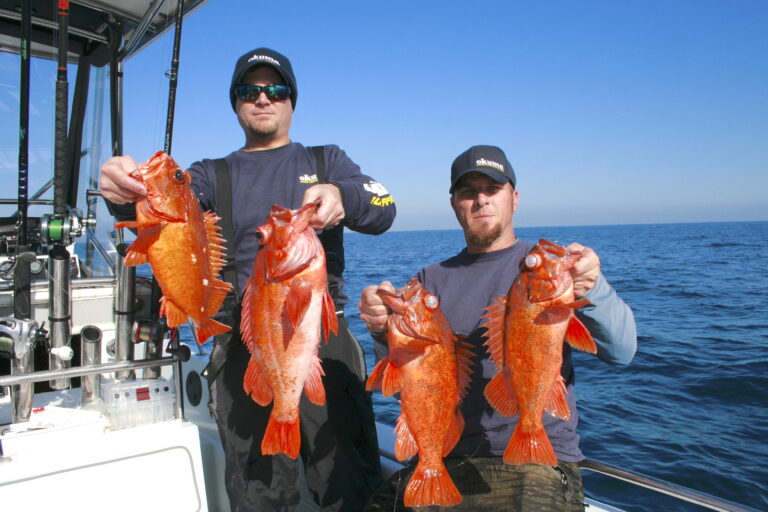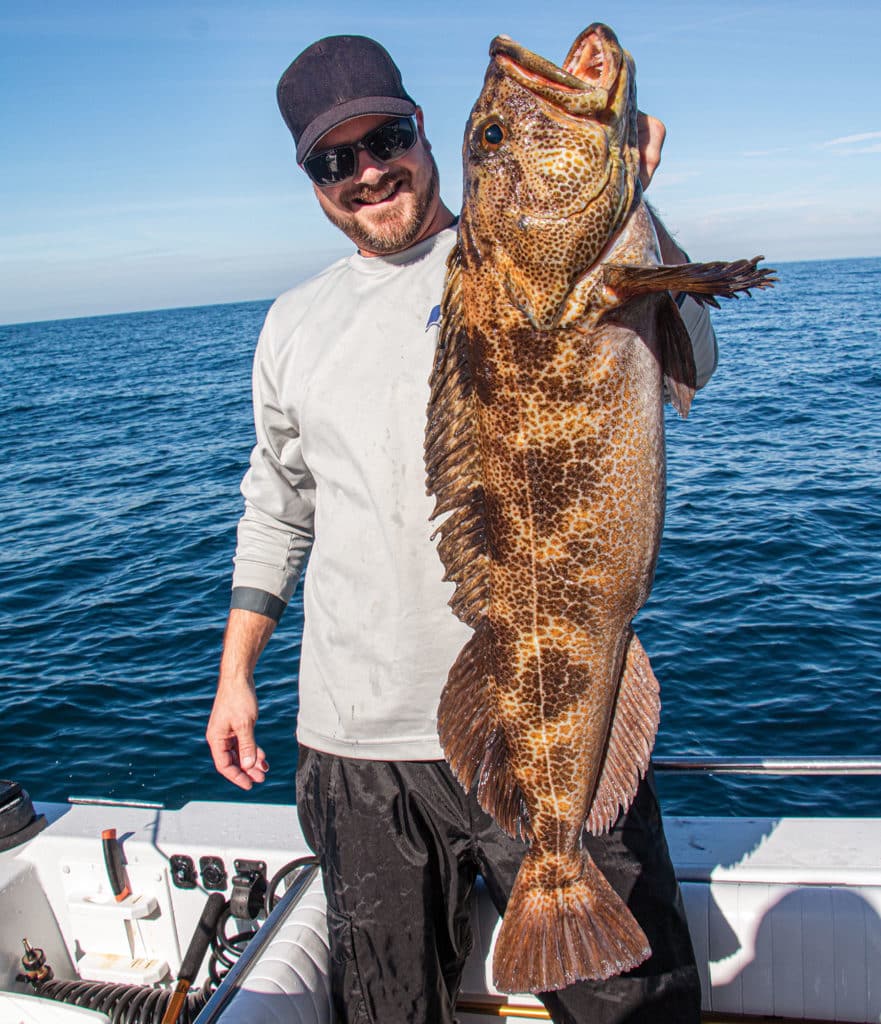
We were catching rockfish one after the other on a deep wreck off Long Beach, California, when I decided to try something different. Instead of the usual strip of squid, I plucked an 8-inch mackerel from the livewell, pinned the hook through its nose, and sent it down.
Within seconds, I felt an aggressive thump, a welcome sign of a fish inhaling the bait. I reeled down and set the hook, and the fish surged downward, heading for the jagged wreck. The rod tip plunged as the fish jerked me to the rail, and line tore off the reel despite the maximum drag.
I fought to regain line and wrest the fish from the structure. Eventually, it gave way and, as it ascended to color, the gaping maw, wicked teeth and camouflaged sides confirmed it was a lingcod. After hoisting it aboard with a big net, I weighed it on a spring scale—a 25-pounder.
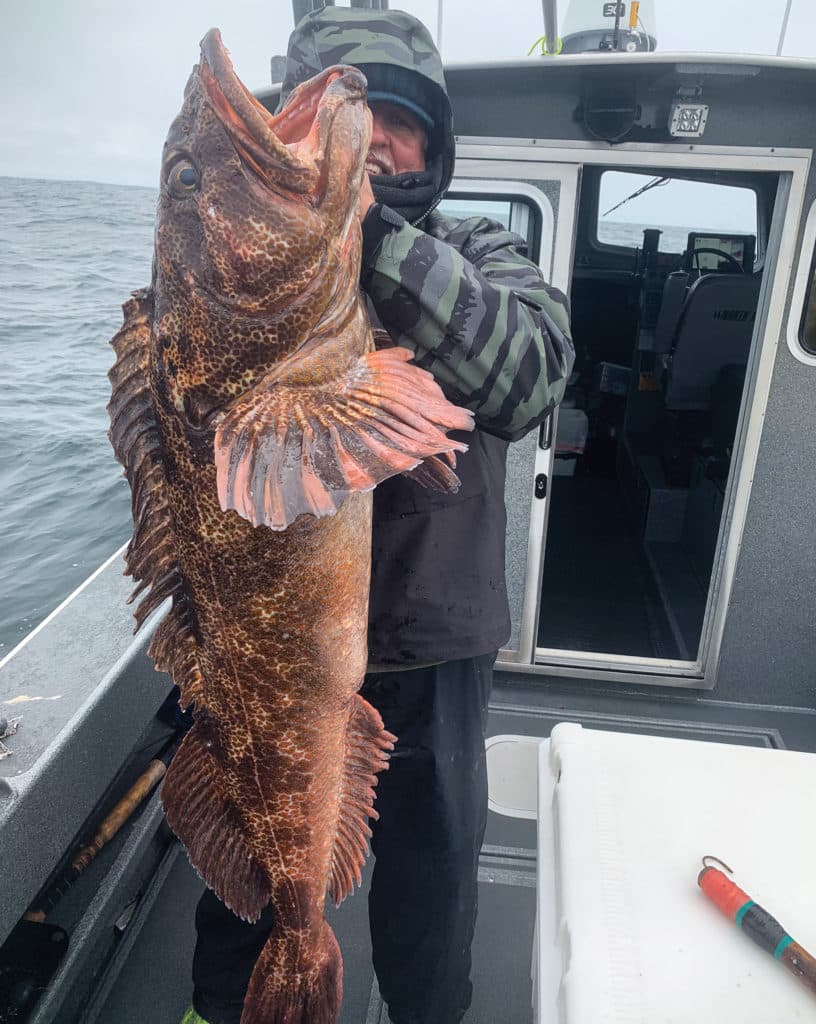
Pacific Prize
Lingcod grow to over 50 pounds off California, with the state record standing at 56 pounds for a fish caught in 1992 in Northern California. But in Southern California, fish of 25 to 30 pounds prove big enough to earn bragging rights.
Lings dwell at great depths along the SoCal coast and around the offshore islands. Often it seems the deeper you fish, the more likely you will hook a big one. Recent changes in the California Fish and Game code have opened up new opportunities for big lingcod. While prior regulations restricted bottomfishing to depths inside 360 feet, depth limits have been expanded recently to 600 feet in many areas.
No matter the depth, the key to success lies in fishing bottom structure such as rocky reefs and wrecks. Prime feeding areas on any structure lie along drop-offs amid caves and cuts, where lingcod wait in ambush among anemones, urchins and gorgonian coral, waiting for current to sweep prey to them. Big lings bully their way into the best spots, forcing the smaller fish out. So, to catch the biggest lings, focus on the edges of structure.
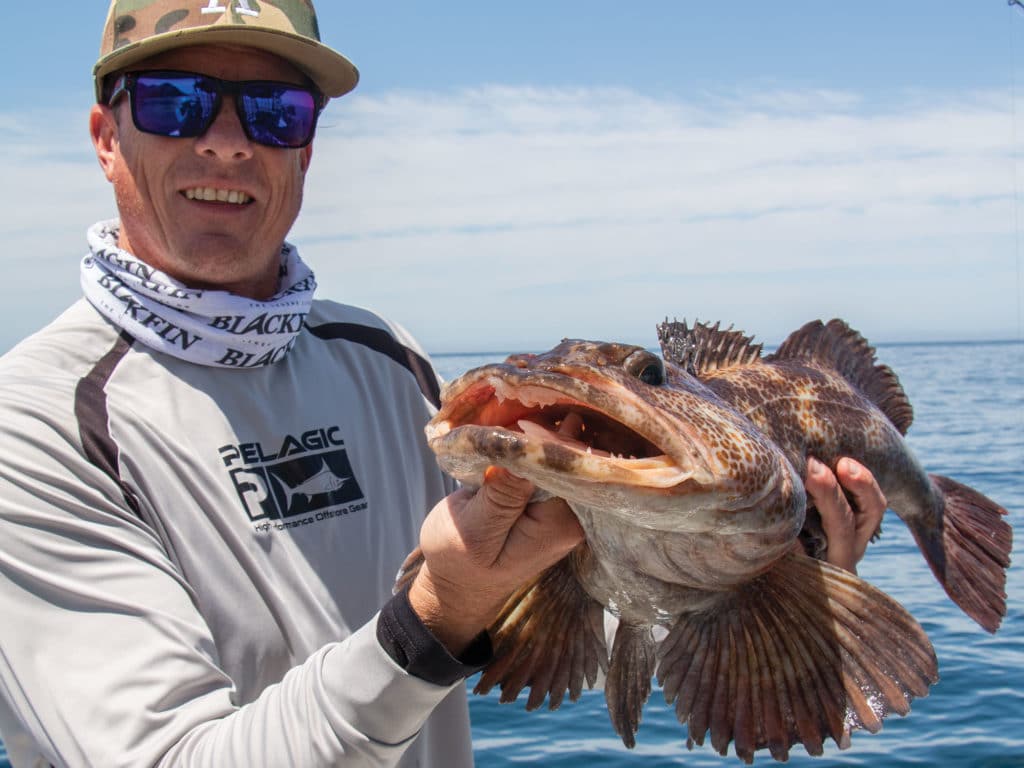
Big Baits
Big baits catch big fish. This proves especially true with lingcod. Anglers catch relatively few fish with the strips of squid used for rockfish. Big, active live baits such as mackerel that broadcast struggle vibrations capture the attention of nearby lingcod.
Other live baits that work well for big lings include sand dabs—6- to 10-inch-long solelike flatfish that anglers catch with sabiki rigs on deep sandy bottom areas, often adjacent to reefs and wrecks—as well as large Pacific sardines, usually available at live-bait receivers in Ventura, Redondo, Long Beach, Dana Point, San Diego Bay and other ports.
Some anglers also use small rockfish, one of the prime forage species for big lings. To that point, sometimes a ling will latch on to a hooked rockfish and refuse to release as you reel both fish to the surface. These hitchhikers often end up on the deck, victims of fatal gluttony, despite never being hooked.
No matter which bait you fish, pin the hook up though the roof of the mouth and out through the top of the nose to keep the bait lively and prevent the hook from turning into the bait.
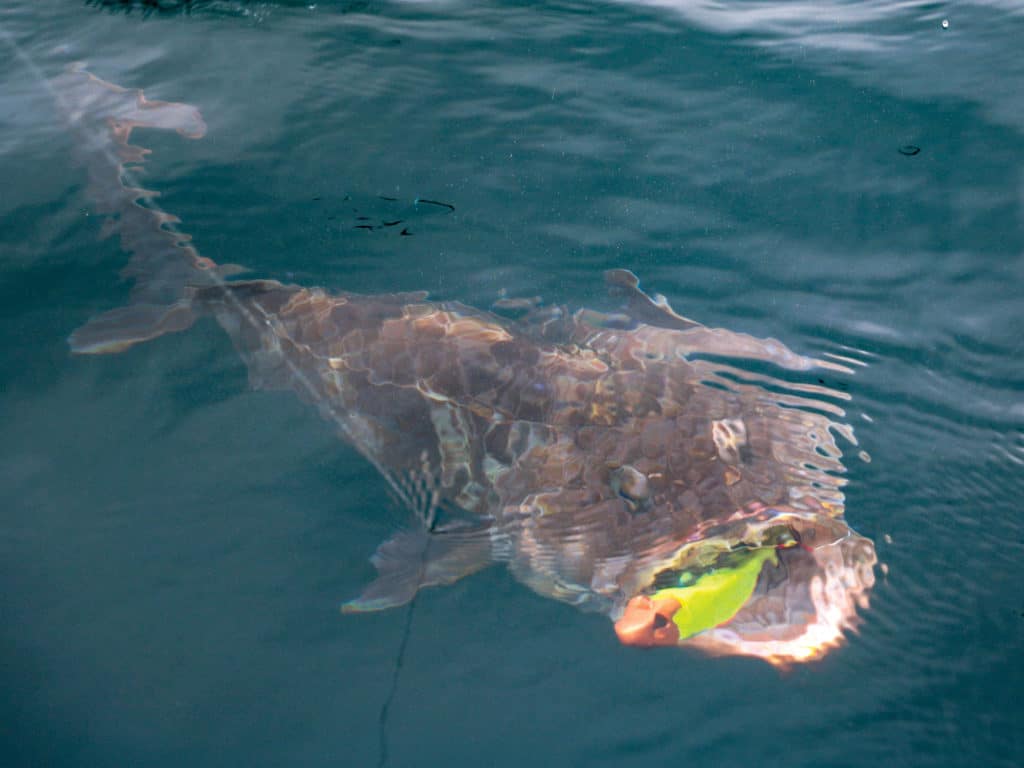
Drift and Drop
Given the depths at which lingcod live, most anglers drift over structure rather than anchor. This requires precision in setting up to put the boat on a productive drift and keep the baits over the structure—which might be a relatively small wreck—as long as possible. A light breeze or current helps because it’s difficult, and sometimes even impossible, to drift effectively in a strong wind.
The technique calls for motoring to the upwind or up-current side of the reef or wreck while anglers stand ready to drop lines. At the starting point, the captain pulls the boat out of gear and anglers drop their baits to the bottom. It’s then a matter of keeping the baits close to the structure where a big ling can grab them.
Keep the line as vertical as possible while drifting in order to avoid snags, sense a bite, and minimize avenues of escape for hooked fish. Once the line scopes out more than 20 degrees, reel in and drop the bait again, or set up for another drift.
Recently, a good alternative to drifting employs a bow-mounted trolling motor with GPS and a virtual-anchor feature to maintain position right over structure for lingcod and rockfish.
Terminal Tackle
Fishing in current-swept depths from 150 to 600 feet requires a terminal rig that accommodates a heavy sinker to present the bait close to the bottom. One of the best is the dropper-loop rig. Start with the reel spooled with 65-pound-test braid, then add a 10-foot top shot of 30- to 40-pound fluorocarbon.
Create an 8-inch loop with a spider hitch about 3 feet from the bitter end of the top shot. Girth-hitch a hook matched to the size of the bait to this loop—I like Owner Aki Twist hooks in 4/0 to 6/0. Use a spider hitch to create a 3-inch loop at the bottom of the top shot, and girth-hitch a 6- to 20-ounce torpedo sinker, depending on the depth and drift speed.
Some anglers add a second loop 18 to 24 inches above the first loop when fishing for rockfish. For lingcod, one hook and one bait prove less cumbersome. Also, two hooked lings on the same rod tend to wrestle the hooks out of each other’s mouths during the fight.
Quick Victory
Around structure, lings possess home-field advantage. With an initial burst of acceleration, a ling can power into the rocks or wreck. You will often feel the ling attack the bait with a pronounced thump, and then nothing. The fish might not be going anywhere, instead choosing to settle back into its lair to enjoy its meal. At this stage, reel down and swing hard to set the hook, then apply maximum pressure with a tight drag. This is when the ling will unleash its fury, so pull with all your might and gain line until the ling is well above the structure.
Power Play
This technique calls for a stout 8-foot rod. Conventional reels with high-retrieve ratios work well and pack enough braid to fish the recently opened deeper waters. Once a big ling is clear of the structure, the battle is in your favor. Settle into a slow grind, maintaining steady pressure. Usually, lings willingly rise from the depths. Resist the urge to pump the fish because this might trigger head shakes that dislodge the hook. Play it right and the ling should glide peacefully to the net.
With extended depth regulations and new bottomfishing opportunities open to anglers, now is the right time to venture off the SoCal coast to fish deep structure with live bait and take your shot at a big ling.
Read Next: Fishing for Lingcod with Large Saltwater Swimbaits
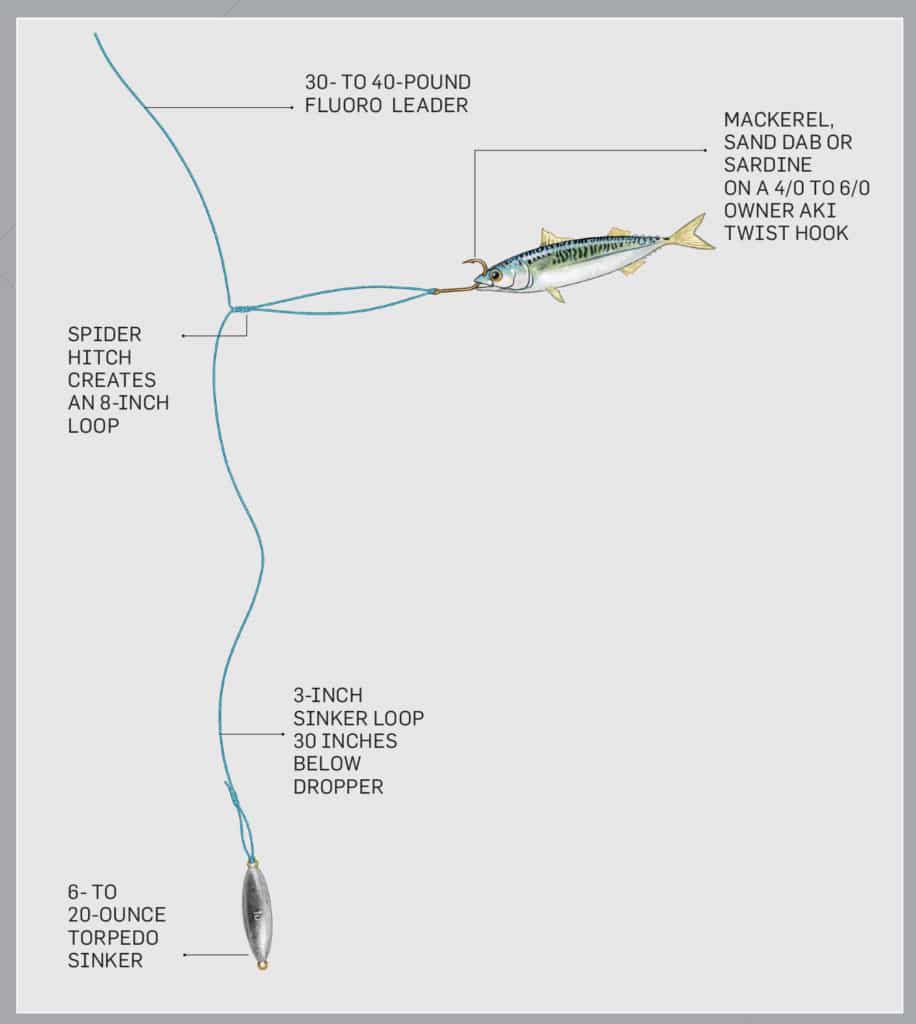
Lingcod Dropper Rig
A dropper-loop rig lets you fish a live bait near the bottom while minimizing snagging on the rocks or wreck. The double-line loop to the hook offers protection against toothy lings biting through the leader and provides additional abrasion resistance against jagged structure where lings dwell. Use a quality fluorocarbon leader with high abrasion resistance.
SWS Planner
- What: Lingcod from 25 to 40 pounds
- Where: Deep structure areas off the Southern California coast and offshore islands
- When: March through December (season closed in January and February)
- Who: Anglers with reliable craft from 20 feet up. If you want to learn more about catching lings, book a trip with one of these top charter captains:
Capt. Jimmy Decker
Fishing with Decker
949-280-4597
facebook.com/fishingwithdecker
Capt. Benny Florentino
Coastal Charters
310-779-0397
Capt. Gerry Mahieu
All Harbors Charter
949-279-6013
SWS Tackle Box
- Rods: 8-foot medium-heavy action, such as a Calstar Grafighter 800M, Seeker 270-8H, Penn Bluewater Carnage 800M or equivalent
- Reels: Conventional, such as an Okuma Tesoro 10S or Shimano Torium 20
- Line: 65-pound braid with 10 feet of 30- to 40-pound-test fluoro top shot
- Terminal Rig: 8- to 10-inch dropper loop formed by a spider hitch with a 4/0 or 6/0 Owner Aki Twist hook. 6- to 20-ounce torpedo sinker on the tag end, 30 inches below the dropper loop
- Bait: Live baits such as Pacific mackerel, jack mackerel, sardines or sand dabs








